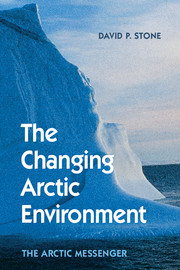Book contents
- Frontmatter
- Dedication
- Contents
- Acknowledgements
- Acronyms
- 1 Personal Beginnings
- PART I THE CHANGING ARCTIC
- PART II WORKING TOGETHER
- PART III WHAT IS THE PRESENT STATE OF KNOWLEDGE?
- 4 Radioactivity
- 5 Heroic Efforts
- 6 Acidification and Arctic Haze
- 7 Stratospheric Ozone Depletion
- 8 Persistent Organic Pollutants and Heavy Metals (Including Mercury)
- 9 Conducting Marine Science in the Arctic
- 10 Climate Change in the Arctic
- PART IV WHAT DOES ALL THIS MEAN?
- Appendix I The Intergovernmental Panel on Climate Change (IPCC)
- Appendix II What Will Happen in the Future If We Do Nothing or If We Try Very Hard to Aggressively Reduce GHG Emissions: Projected Change Under Different Emission Scenarios
- Appendix III Some Geophysical Background Notes Related to Climate and Weather
- Appendix IV Orbital Forcing
- Appendix V The Concept of Commitment
- Bibliography
- Credits
- Index
5 - Heroic Efforts
from PART III - WHAT IS THE PRESENT STATE OF KNOWLEDGE?
Published online by Cambridge University Press: 05 February 2015
- Frontmatter
- Dedication
- Contents
- Acknowledgements
- Acronyms
- 1 Personal Beginnings
- PART I THE CHANGING ARCTIC
- PART II WORKING TOGETHER
- PART III WHAT IS THE PRESENT STATE OF KNOWLEDGE?
- 4 Radioactivity
- 5 Heroic Efforts
- 6 Acidification and Arctic Haze
- 7 Stratospheric Ozone Depletion
- 8 Persistent Organic Pollutants and Heavy Metals (Including Mercury)
- 9 Conducting Marine Science in the Arctic
- 10 Climate Change in the Arctic
- PART IV WHAT DOES ALL THIS MEAN?
- Appendix I The Intergovernmental Panel on Climate Change (IPCC)
- Appendix II What Will Happen in the Future If We Do Nothing or If We Try Very Hard to Aggressively Reduce GHG Emissions: Projected Change Under Different Emission Scenarios
- Appendix III Some Geophysical Background Notes Related to Climate and Weather
- Appendix IV Orbital Forcing
- Appendix V The Concept of Commitment
- Bibliography
- Credits
- Index
Summary
Any scientific activity in the Arctic is likely to be very expensive and even today can be hazardous. There are several ways one can go about it. The project may have modest requirements for new data and/or does not require a scientist to be in a remote part of the Arctic. In this case, there may be little difficulty in finding sufficient additional funds to do the job. For example, the existing capabilities of satellite borne remote sensing may be used or perhaps the data gathering can be done within or a short distance from an Arctic community. However, if the project requires physically travelling away from Arctic communities, ships and aircraft are involved and costs skyrocket. If the geographical coverage of the project and/or the length of observations is extensive, the mobilization of national and perhaps international scientific cooperation will be needed for the science itself and for the logistics.
If the objective is to study how something changes over time and space (such as concentrations of a particular contaminant), a network of observing stations will be required. This strategy usually starts with some existing national networks and the task is to expand these precursors in ways that reflect the time and space demands of whatever is the object of study. The key attributes for success are ensuring that methods and equipment provide comparable data, the data are freely available and that arrangements will be sustainable for a long period of time. Much of the Arctic Messenger's story is derived from this type of monitoring (such as that organised by Arctic Monitoring and Assessment Programme [AMAP]). Recently, the Arctic Council launched an activity called the Sustaining Arctic Observing Networks (SAON), designed to enhance the circumpolar capability of this type of approach in the Arctic and to expand the focus beyond the types of data traditionally used for environmental monitoring.
- Type
- Chapter
- Information
- The Changing Arctic EnvironmentThe Arctic Messenger, pp. 70 - 75Publisher: Cambridge University PressPrint publication year: 2015



